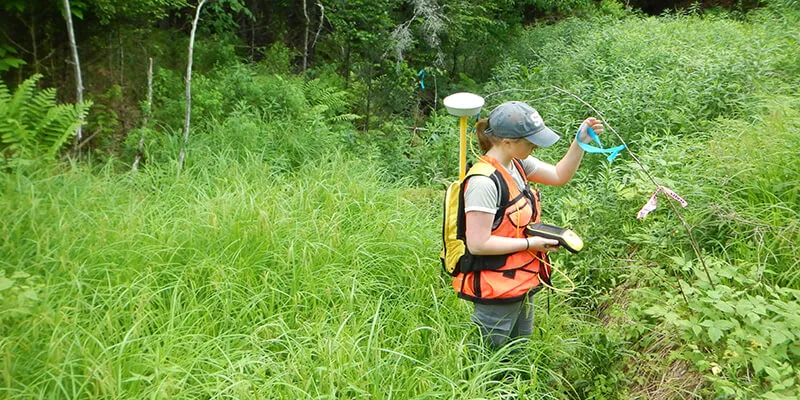During my internship at Vanasse Hangen Brustlin, Inc. (VHB) in South Burlington, Vermont, I had the privileged opportunity to spend the summer as an environmental scientist. As an intern, I worked alongside environmental professionals at VHB, while getting firsthand experience at what a field season as a professional would be like.
I spent most of the summer working in the field across the state collecting data for various projects. This included wetland and stream delineations along power corridors, non-native and invasive species (NNIS) and rare, threatened, and endangered (RTE) vegetation identification and mapping, and well and stream data logger installation. I traveled from Mount Snow to Lowell, Vermont and saw many different ecosystems and parts of the state I had never seen before. I also spent some time in the office completing U.S. Army Corps of Engineer data sheets, filing Act 250 permits, updating and managing GIS maps, and creating plant lists and photologs with the data collected in the field.
In this internship, I gained a basic understanding of what environmental consulting is. In doing so, I accomplished one of my learning objectives to learn how VHB plays a role in upholding Vermont’s environmental and natural resource standards. VHB collects data and information about projects and their potential impacts to the environment, which in most cases is gathered and given to the state to ensure all standards are being met and maintained.
My second learning objective was to learn Vermont’s water quality standards and how samples are analyzed. Although I did not learn what the specific water quality standards and regulations are, I had the opportunity to assist in several projects where data loggers were installed to monitor water quality and activity. I also collected water samples at stream sites and brought them to a separate laboratory that chemically analyzes samples.
Lastly, when mapping the wetlands and streams that were delineated in the field, I gained new skills for working in GIS and GPS software. This allowed me to accomplish my last learning objective, which was to make GIS maps and proficiently operate the software. I did not become an expert in GIS, but gained new experience working with the software.
I would advise future interns to come into the internship willing to try new things. On my second day, I was sent into the field for two weeks in environments I was unfamiliar with and technology I had never used before. It was necessary for me to quickly adjust to the new schedule and work load in order to successfully accomplish the task at hand. Additionally, I recommend that future interns should be able to take initiative in this internship. Work within the office is not always readily available and it is important to independently figure out meaningful things to do for projects. I found it useful to reach out to coworkers or look at similar projects that were done in the past to figure what type of reports or documents needed to be completed for the projects we were working on. Lastly, I found it important to be open and friendly with everyone I worked with. During several small conversations with people I met, I made professional connections that may help with future opportunities within and out of Vermont.
